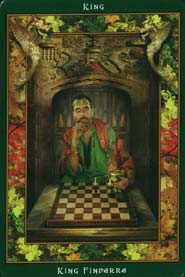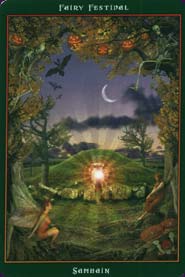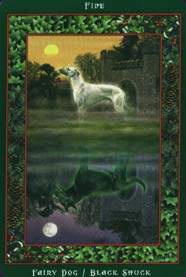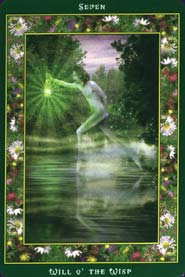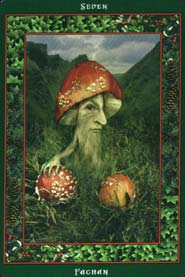Fairy Ring Oracle Deck Review
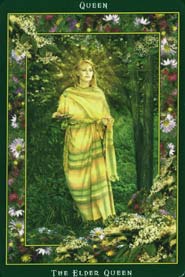
Creators: Anna Franklin, Paul Mason
Published: 2002
The Fairy Ring Oracle is the very beautiful second deck from the creators of the Sacred Circle Tarot. This one is based on British and Irish fairy legends and has fours suits of fourteen cards and eight 'fairy festival' cards.
Retailers
See Price at Amazon.comSee Price at Amazon.co.uk
See Price at Amazon.ca
Fairy Ring Oracle Review by Solandia
The Fairy Ring Oracle, the second deck from Anna Franklin and Paul Mason, creators of the Sacred Circle Tarot, is not a set of a tarot cards but a sixty-card oracle deck. Its cards do not have pretty Victorian fairies with blonde hair and gossamer wings, but the full spectrum of naughty, nice, troublesome and plain malicious fairies and sprites from Britain and Ireland.
The Fairy Ring Oracle it has four suits - the Spring Court, the Summer Court, Autumn Court and Winter Court - and eight 'Fairy Festival' cards representing the Sabbats and Esbats of the year. Each of the suit cards is associated with a figure from the fairy pantheon, like Mab or Gwynn ap Nudd, or one of the Fairy species like Brownie, Leprechaun or Unicorn. The fives are slightly different, being day/night reversals of animal fairies: the Five of the Spring Court is the Fairy Hart upright and the Unicorn reversed.
The cards have dark green borders, and a seasonally themed inner leafy border according to the suit. Created in a very similar photomontage style to the Sacred Circle Tarot - and even with some of the same people - the Fairy Ring's art blends photo and illustration with more finesse. Some cards do show evidence of their computer-generated origins (there are a few female fairies, particularly the White Lady, who look rather like Lara Croft) but graphics programs have come a long way since the Sacred Circle deck was published in 1998. The overall effect of the deck is far smoother and more polished; some of the fairies are blend seamlessly with their background and appear positively realistic. Jack Frost… Fachan… Brownie… Jenny Greenteeth… And Boggart, the Three of the Winter Court... not something I'd like to meet on a cold and dark night. Other cards, like The Elder Queen and, my favourites, the four Sabbat cards of the Fairy Festivals, are just magical.
The Guide to the Fairy Ring is the standard size Llewellyn companion book packaged with the Fairy Oracle cards. It has a quick introduction on the fairies in the deck, a couple of pages of very basic instructions on how to use the cards, and nine different spreads. (Some of these spreads, the Fairy Oak, The Fairy Mound, the Fairy Market and the Fairy Ring are printed on blank white cards the same size as the rest of the deck.) The rest of the book is devoted to explaining the cards, describing the art, the associated fairies traits and legends, divinatory meanings, reversed meanings, and how to work with that fairy. (Or not - it is not recommended to work with a Bogeyman, for example.)
Don't knock it because it's not a tarot deck… if you like fairies, British and Celtic legends, or visually stunning art, don't miss the beautiful Fairy Ring.
Fairy Ring Oracle Review by Bonnie Cehovet
Anna Franklin and Paul Mason (co-creators of the Sacred Circle Tarot) have done a wonderful job of creating a non-Tarot divinatory deck using Celtic myth. Ms Franklin brings with her a background of thirty years as a practicing Pagan (sixteen years as a High Priestess), and many years of collecting and studying Celtic folklore. If you ever wanted to work with leprechauns, elves and other fairy folk - here is your chance. A word of warning - these are not all gossamer winged little fairies! Presented here is a good representation of all of the energies of the "other world" - helpful, mischievous and dangerous."The Fairy Ring" is presented somewhat in the format of the Tarot: there are four suits, representing the four elements, and four court cards to each suit. The pips in this deck, however, only go up to nine - the transitional ten of the Tarot has been left off. There is no Major Arcana, although similar energies are expressed in the eight Fairy Festival cards (which represent the four fire festivals of the Celts and the solstices and equinoxes of each year). They do form a journey of sorts, but not the Fool's Journey of the Tarot.
Franklin starts out with a brief introduction into the Fairy world - interesting and concise, a good basis for working with the cards. She then talks about setting up a reading. She does not talk about framing the question, but she does insist on the use of reversals. I think the framing of the question should be addressed, as it is integral to the reading - it is indeed the foundation for the reading. As for reversals - I feel that is up to the reader, and should never be "insisted" upon. These are my personal "quirks"!
The next section is one that I look for in every book on divination - the presentation of spreads! I am always looking for new spreads to work with, and I was quite impressed with what I saw here. I find them important enough to list them here:
The Fairy Mound: This is a thirteen card spread used for looking into issues/events from the past, how they effect the present and how best to move into the future.
The Fairy Oracle: This is a seven card linear spread used to address a single question.
The Fairy Gifts: This is a five card spread used to determine the skills the Seeker will need to fulfill his/her destiny.
The Fairy Market: This is an eleven card spread useful for general readings or single questions.
The Year Spread: This is a twelve card spread that shows the influences coming in over the next year. Franklin suggests doing this at the beginning of the year, but does not indicate if she is referring to the calendar year, or to the Seeker's "new year", which begins at their birthday. I vote for doing these types of readings starting with the birthday for a "personal" year.
The Life Reading: This is a twelve card reading used for in-depth analysis of the Seeker's life.
The Wildfolk Guides: This is a seven card reading that helps the Seeker access supportive fairy energies.
The Fairy Oak: This is a ten card reading that looks at the cause of an issue, and how the present circumstances came about.
The Fairy Ring: This is an eight card reading that gives a life overview, and how to best proceed into the future.
Four of these spreads are presented on cards the same size as the deck, with layout graphics and positional information. These are: the Fairy Ring, The Fairy Oak, The Fairy Market and The Fairy Mound. I find these very handy - and they can also be transferred to other divinatory systems, such as Tarot or the Runes.
The cards themselves are a nice size for small hands - approximately 3" by 4 1/2 ". They are on good quality, glossy card stock. The backs of the cards are a textured earth green, with entwined "Celtic-knot" type circles in the center (for those who read with reversals, a reversed card would not be evident until it was turned over).
The front of the cards has a dark green 1/4 inch outer border, with an inner border color coded to the suit. The card number is at the top, in white lettering; the card title is across the bottom, in white lettering. The artwork in this deck is imaginative and evocative, leaving one with a sense of having truly journeyed amongst the fairy people! The Five of The Winter Court(Fairy Dog/Black Shuck) shows a white dog standing in profile in front of a castle like structure, in the moonlight. Reflected in the water below is the same scene - with a black dog. The Six of the Spring Court (Garconer) is a very Buckland-Romani style setting, with a young gypsy looking elf standing in front of a gypsy tinkers cart/caravan. The Fairy Festival card for HerFest shows a circle of winged fairies, with the Poppy Fairy in the foreground and a fairy hunter stalking his prey. The fairy castle stands, shrouded in mist, on an island in the background. The Ace of The Winter Court (Knocker) shows a stone building (an abandoned engine house for a tin mine) in the background, with a Raven flying near it and a series of four dark fairies (that normally live in the mine) with lanterns in hand, carrying mining tools, walking down the hill.
Each card is presented with a black and white scan, a description of the card, a description of the fairy energy, divinatory meanings, reversed meanings, and a section on pathworking that shows how to work with the energy of the card. (Please note: not all fairy energy is to be worked with. Ms Franklin does note when this is the case - as an energy worker, I think it is best to take heed here.)
I found it interesting that Franklin notes that the specific names of the fairies are sacred - not to be mentioned. We see this also in cultures such as the Native American - I find this something to take heed of, as the energies being worked with are exceedingly powerful. The fairies also wish not to be thanked - something that I never would have known, and will keep in mind, as I do intend to do some of the pathwork from this book.
Here is a sample presentation from the book, that of the Fairy Festival card Ostara:
The Card: The card shows a mysterious fairy island. Fairy islands appear and disappear in the twinkling of an eye, and may never be seen in the same place twice, though a few lucky humans have been able to visit them. It is the Spring Equinox, also called Ostara, when many fairies emerge from their winter hideaways. Some of them can be seen on the cards, such as the formidable woodwose and the pretty winged fairy in the foreground. Early daffodils decorate the foreground.
The Festival: At the spring equinox - called Ostara by the Saxons - the days have noticeably lengthened. Day and night are of equal length, but the light is gaining and spring has really arrived. Birds are busy building nests, and young animals are mating. Green leaves appear on the trees, and drifts of daffodiles appear in the hedgerows.
As the weather starts to brighten, some good fairies emerge from their winter hideaways, and others become more active. Some shed their winter skins and adopt a fresh guise for the coming summer. If fairies are denied their rightful portion of the festival feast, you will have to give them twice as much at midsummer, or you will be troubled until the next Ostara.
Many fairies are associated with vegetation, crops and the fertility of the land, with the power of either blessing or blighting. These fairies may be directly related to ancient vegetation sprites. In winter the spirit of vegetation seems to die, to go down as seed into the earth until it is resurrected the next spring. Ancient religion was largely concerned with entreating the gods and nature spirits to provide the harvest. It was often thought that when fairies awake in the spring, sacrifice should be made to them, perhaps an offering of milk, honey, cream, melted butter, or, in some cases, a cock.
In Britain and elsewhere in Europe, the vegetation spirit is portrayed as the Green Man or woodwose at spring festivals, a symbol of regeneration, vegetation, life and hope.
At the equinox, many fairies bathe in rivers and streams. It is safer for humans to stay away from such places, or the fairies might take them away or drown them in the water.
Divinatory Meaning: When the festival card of Ostara appears in a spread, it heralds dawning creativity , emergence, an inpouring of energy and ideas, versatility, dexterity, idealism and individuality. An idea or situation begins to crystallize or take form.
Reversed Meanings: The reversed card denotes restlessness, wasted energy, rashness, impatience, superficiality, indecisiveness, thoughtlessness and inconsistency.
I highly
recommend this deck - for the artwork as well as the
wonderful Celtic background, and the gift of peeking into
the "other world" and pathworking with them.
Complete Details of Fairy Ring Oracle
Creators: Anna Franklin, Paul MasonPublisher: Llewellyn 2002
Deck Type: Oracle Deck
Cards: 60
Card Back: Unknown
Rating: 18/20 or
Similar Decks to Fairy Ring Oracle
Theme: Celtic, FairyCreator: Sacred Circle Tarot by Paul Mason Pagan Ways Tarot, Sacred Circle Tarot by Anna Franklin
< Previous Deck · Back to Top · Next Deck >
Home > Tarot Reviews > Fairy Ring Oracle Review

